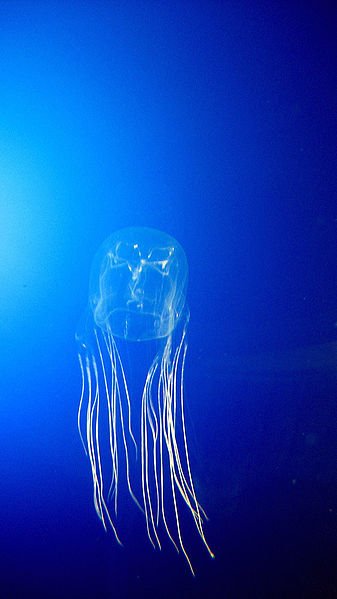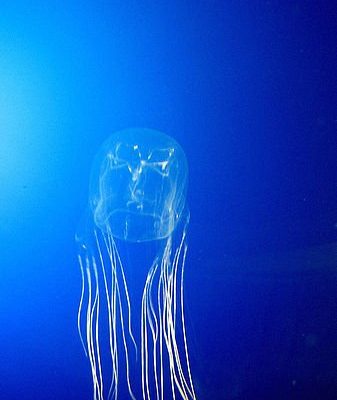
You might be wondering why this creature is so interesting or even worth learning about. Well, the box jellyfish is not just another pretty face in the ocean; it has remarkable adaptations and some seriously cool biological traits. From its incredible speed to its mind-boggling number of eyes, the box jellyfish is a marvel of nature. Here are ten cool things you probably didn’t know about this fascinating jellyfish.
1. The Box Jellyfish’s Venom is One of the Most Potent
Let’s start with a shocking fact: the box jellyfish has some of the most potent venom in the animal kingdom. Its tentacles contain thousands of specialized cells called nematocysts, which can deliver a powerful sting. This venom affects the heart, nervous system, and skin cells of its prey, usually small fish and invertebrates. Just imagine having the ability to paralyze your dinner—pretty wild, right?
If a human is stung, it can lead to intense pain, heart failure, or even death. Yes, you read that right. Some species of box jellyfish are known to cause fatalities in mere minutes. That’s why, if you find yourself swimming in their territory, it’s best to keep an eye out and avoid these swimming wonders.
2. They Can Swim Fast
Unlike many jellyfish that just drift with the current, the box jellyfish can actually swim quite fast. It can reach speeds of up to 4 knots, or about 4.6 miles per hour! For a creature usually associated with laziness and drifting, that’s impressive.
This ability helps them hunt down prey more effectively. They can even change direction quickly to pursue fish or escape from predators. Imagine being able to dart around the ocean like a pro swimmer while still looking like a graceful ghost. Pretty cool, right?
3. A Unique Body Structure
Box jellyfish have a distinct body shape—hence the name “box.” Unlike most jellyfish, which have a round or bell-shaped body, the box jellyfish has a cube shape. This unique structure is not just for show; it allows them to maneuver quickly in the water.
Their body is made up of a thick, gelatinous substance filled with water. This composition gives them buoyancy and flexibility, making them masters of ocean navigation. The jelly’s four tentacles hang from each corner of the box, creating an almost whimsical, tentacled creature gliding through the waves.
4. They Have More Than One Type of Eye
Surprisingly, box jellyfish possess up to 24 eyes! Yes, you heard that right. They have a combination of simple eyes and complex ones, which allows them to detect light and movement. Some of their eyes can even help them see shapes, enabling them to navigate their environment better.
Here’s the thing: while they can’t see in the same way that we do, their vision helps them avoid obstacles and find food. Can you imagine having that many eyes? It must be quite a sight—literally!
5. They Can Grow Quite Large
Box jellyfish come in various sizes, but some species can grow impressively large. The Chironex fleckeri, for example, can reach a bell diameter of about 30 centimeters (almost a foot) and can weigh several kilograms. That’s pretty substantial for a jellyfish!
Their size helps them be more effective hunters and makes them a more intimidating presence in the water. Just think about encountering a giant, cube-shaped jellyfish on your beach day. Would you swim with it, or would you prefer to chill on the sand?
6. They’re Masters of Camouflage
One of the coolest things about the box jellyfish is its ability to camouflage with its environment. The jelly’s translucent body makes it almost invisible in the water, which is an effective tactic for both hunting and avoiding predators. It floats almost like a ghost, making them difficult to spot.
This camouflaging ability can be likened to a magician’s trick—here one moment, gone the next! Predators like sea turtles might not always see them coming, which means that the box jellyfish gets to survive another day.
7. They Play a Role in the Ecosystem
While they might seem like dangerous drifters, box jellyfish play an important role in the marine ecosystem. They are both predator and prey. As they hunt smaller fish, they help keep the populations of those fish in check, maintaining a balance in the ecosystem.
On the flip side, their jelly-like bodies serve as a food source for larger creatures, like certain species of sea turtles. This relationship keeps the chain of life flowing smoothly in their ocean habitats.
8. They Exhibit Interesting Behavior
Box jellyfish have some curious behaviors that set them apart from other jellyfish. For instance, when they feel threatened, they can often swim faster or change direction abruptly to escape predators. You might think of them as the “ninja” of the jellyfish world, using their speed and agility to navigate danger.
They can also exhibit a form of collective behavior, where groups of box jellyfish can be seen swimming together. This phenomenon can help them hunt more efficiently or protect against predators. So, next time you see a group of them, just remember—it’s not just a jellyfish party; they have a plan!
9. They’re Found in Warm Waters
Box jellyfish prefer the warm waters of the Pacific and Indian Oceans. You can find them around coastal areas in countries like Australia, Thailand, and Hawaii. If you’re planning a trip to these beautiful beaches, it’s essential to be aware of their presence.
The warm waters provide the perfect breeding ground for these creatures, allowing them to thrive. So, if you’re swimming in these areas, it’s wise to pay attention to local warnings about box jellyfish and take precautions. Better safe than sorry!
10. Their Life Cycle is Fascinating
The life cycle of a box jellyfish is pretty fascinating. Like all jellyfish, they start their life as a tiny larva after fertilization. This larva eventually settles on a surface and develops into a polyp, where it can reproduce asexually.
Eventually, the polyp releases young jellyfish called ephyrae into the water. These little jellies grow into fully matured box jellyfish over time. It’s almost like watching a series of transformations, akin to a superhero origin story—but instead of a cape, you get tentacles!
In conclusion, the box jellyfish is not just an intriguing creature; it’s a vital part of our ocean ecosystems. From its dangerous venom to its unique body structure, there’s so much to appreciate about this jellyfish. The next time you think of jellyfish, remember how cool and complex they truly are. Whether you’re a marine enthusiast, a curious ocean lover, or someone who just stumbled upon the wonders of the box jellyfish, there’s always more to learn about this captivating creature. So, keep exploring and discovering the amazing world beneath the waves!

